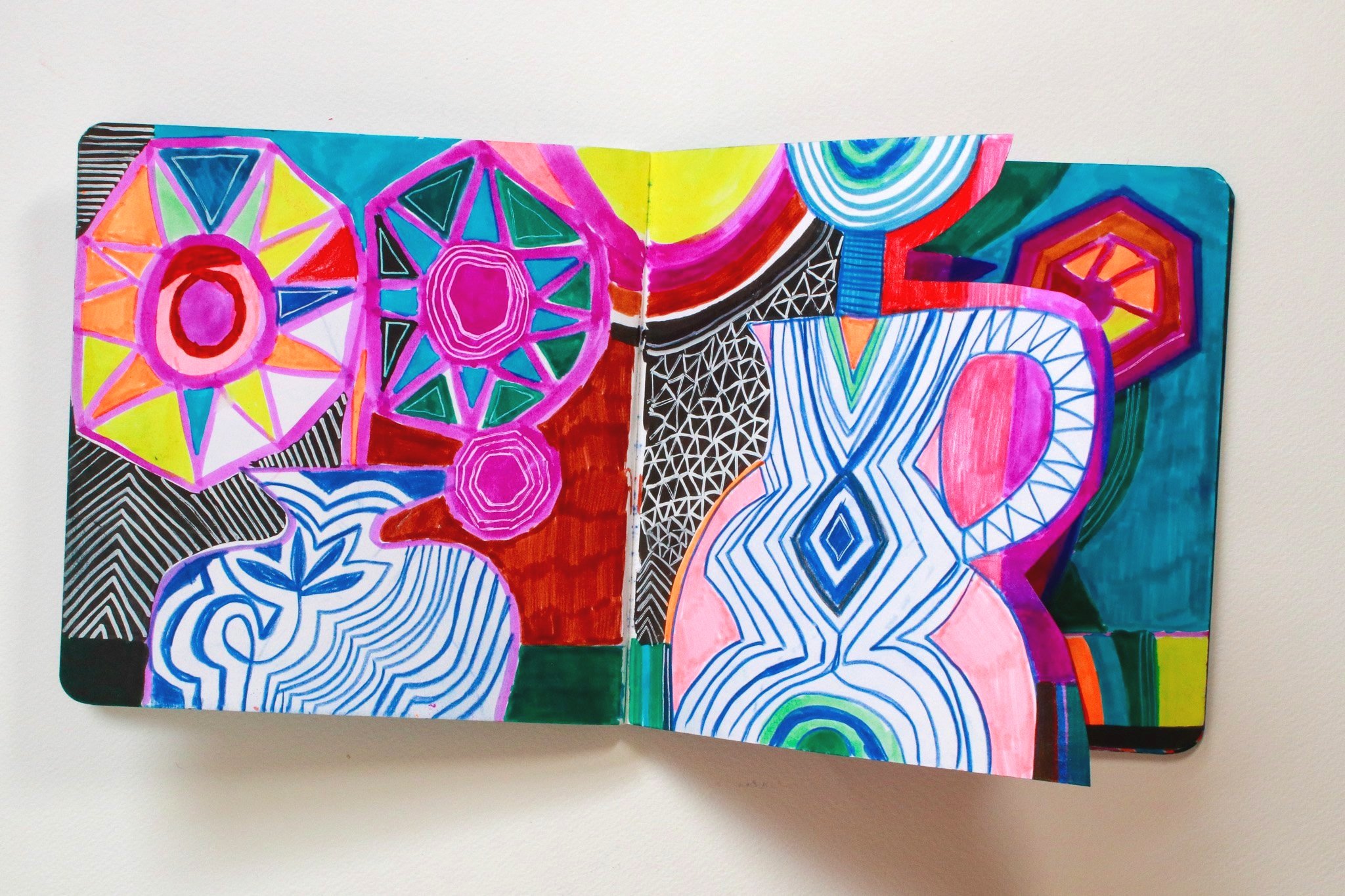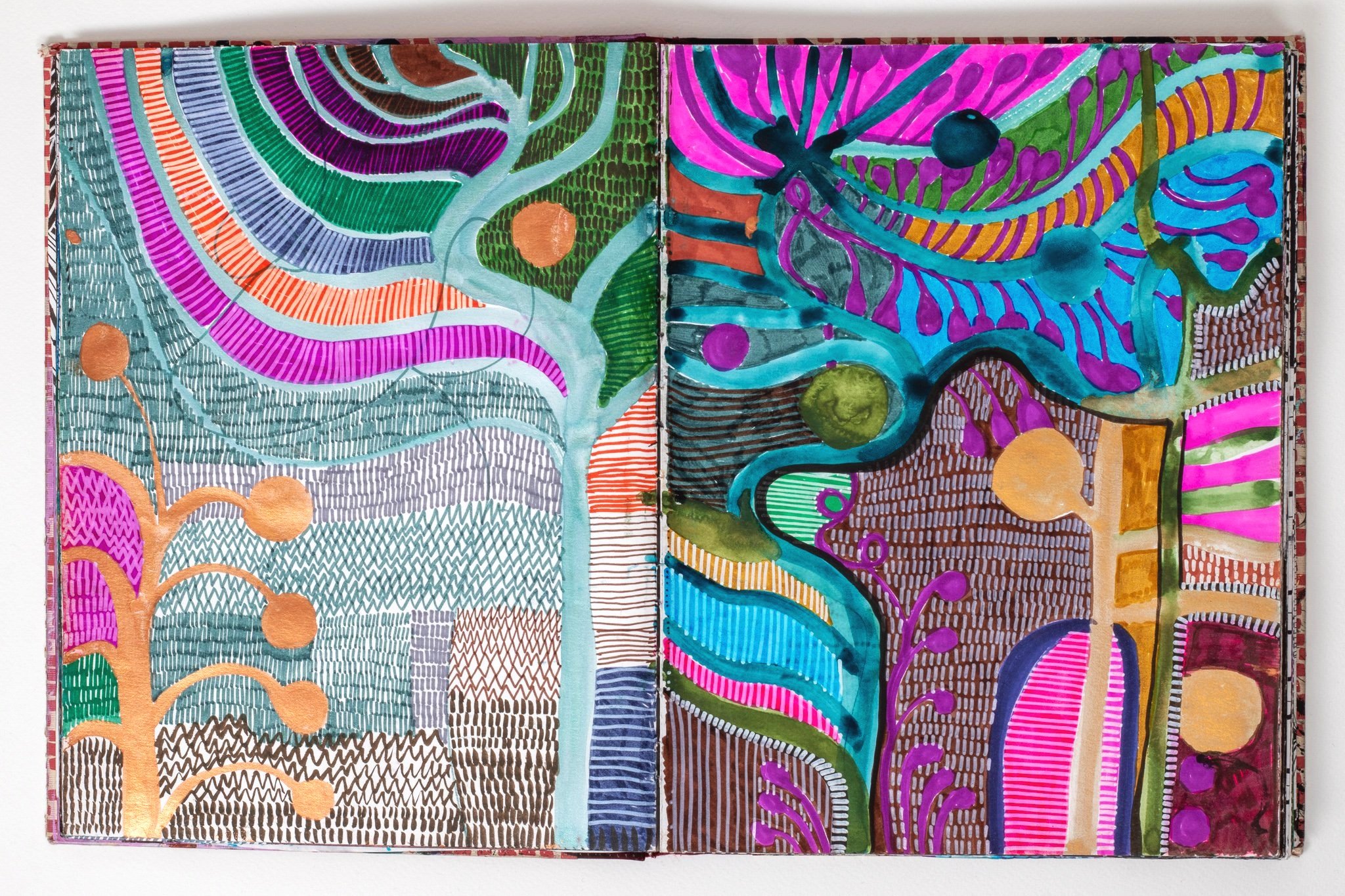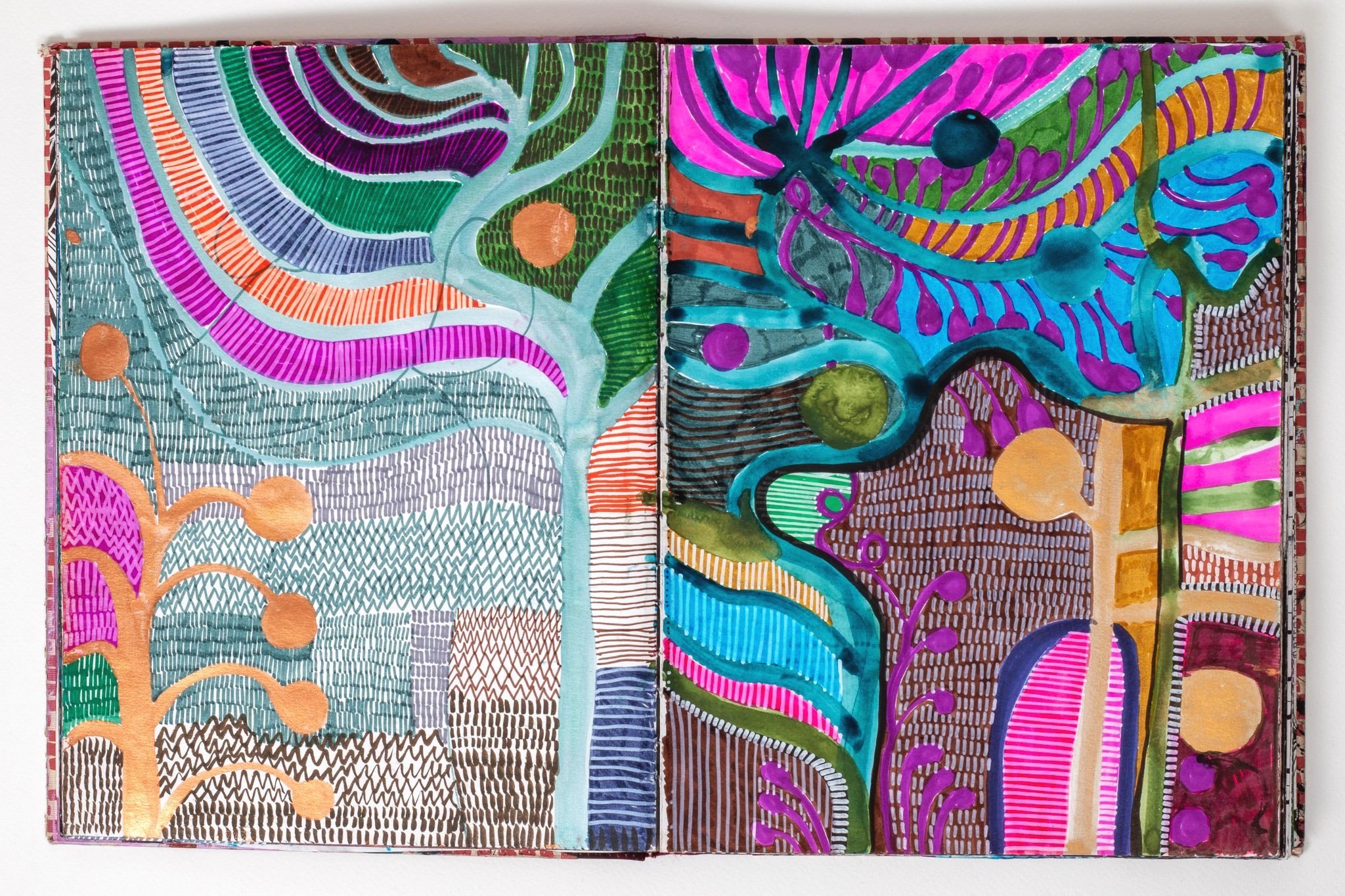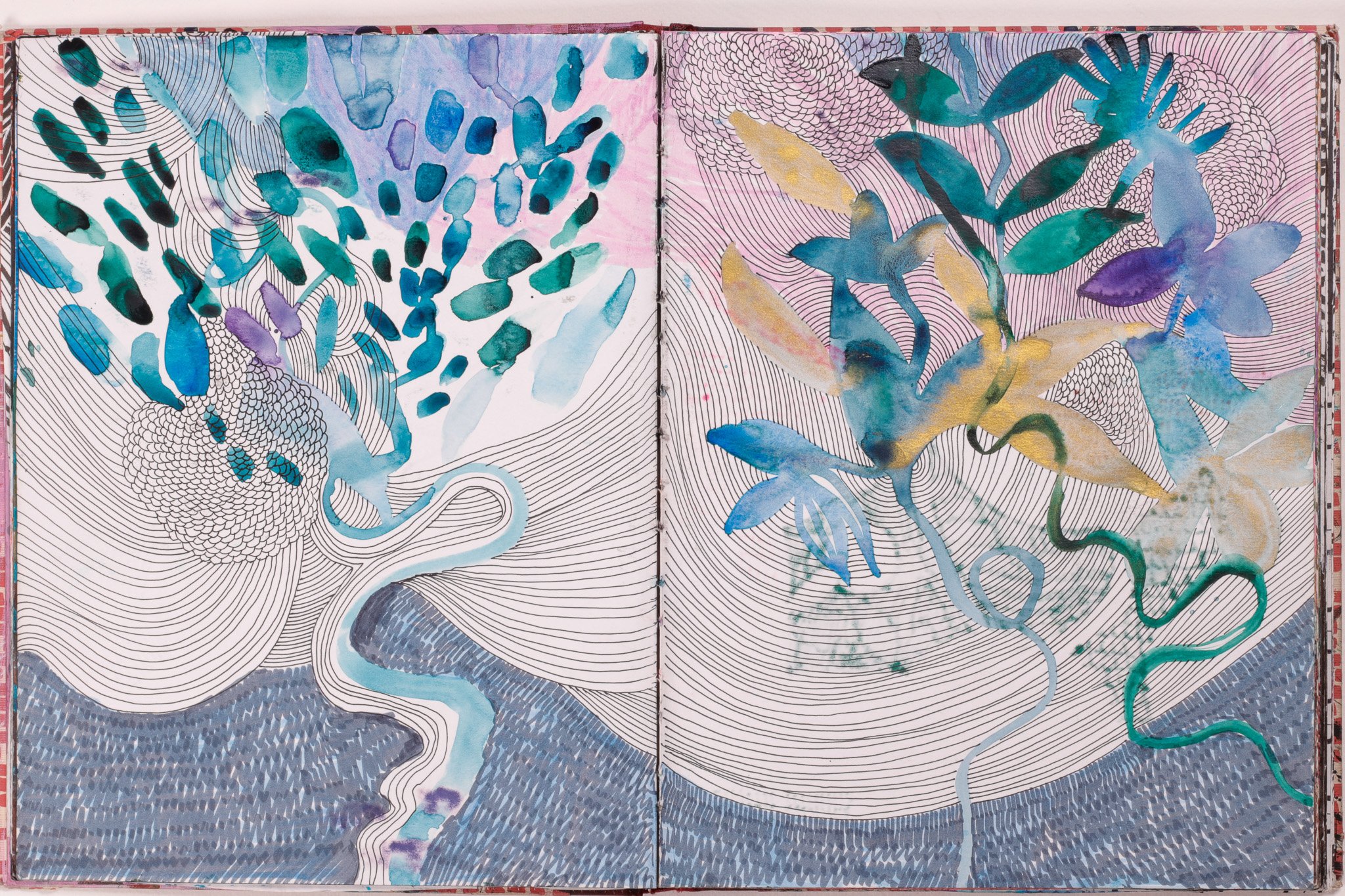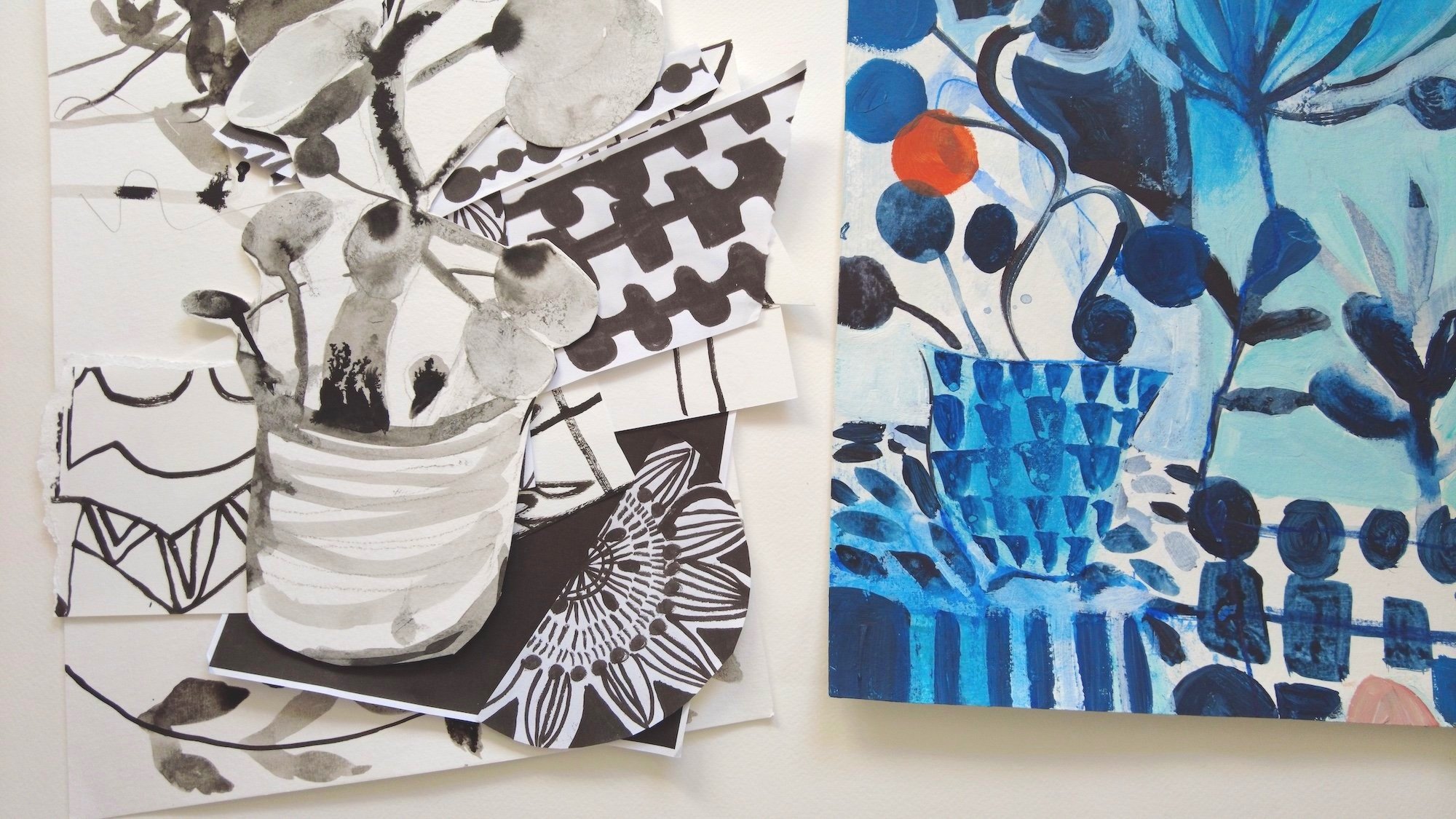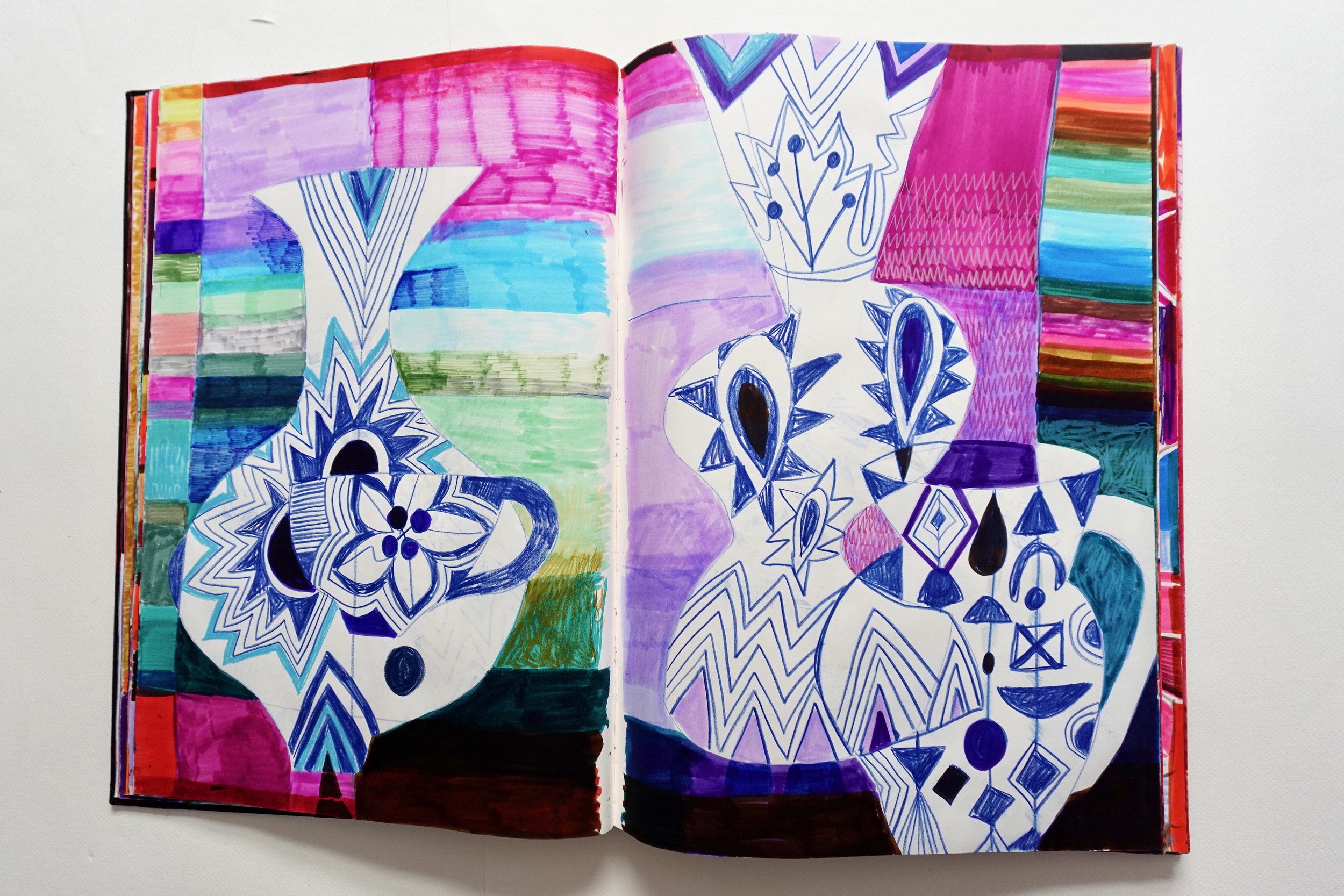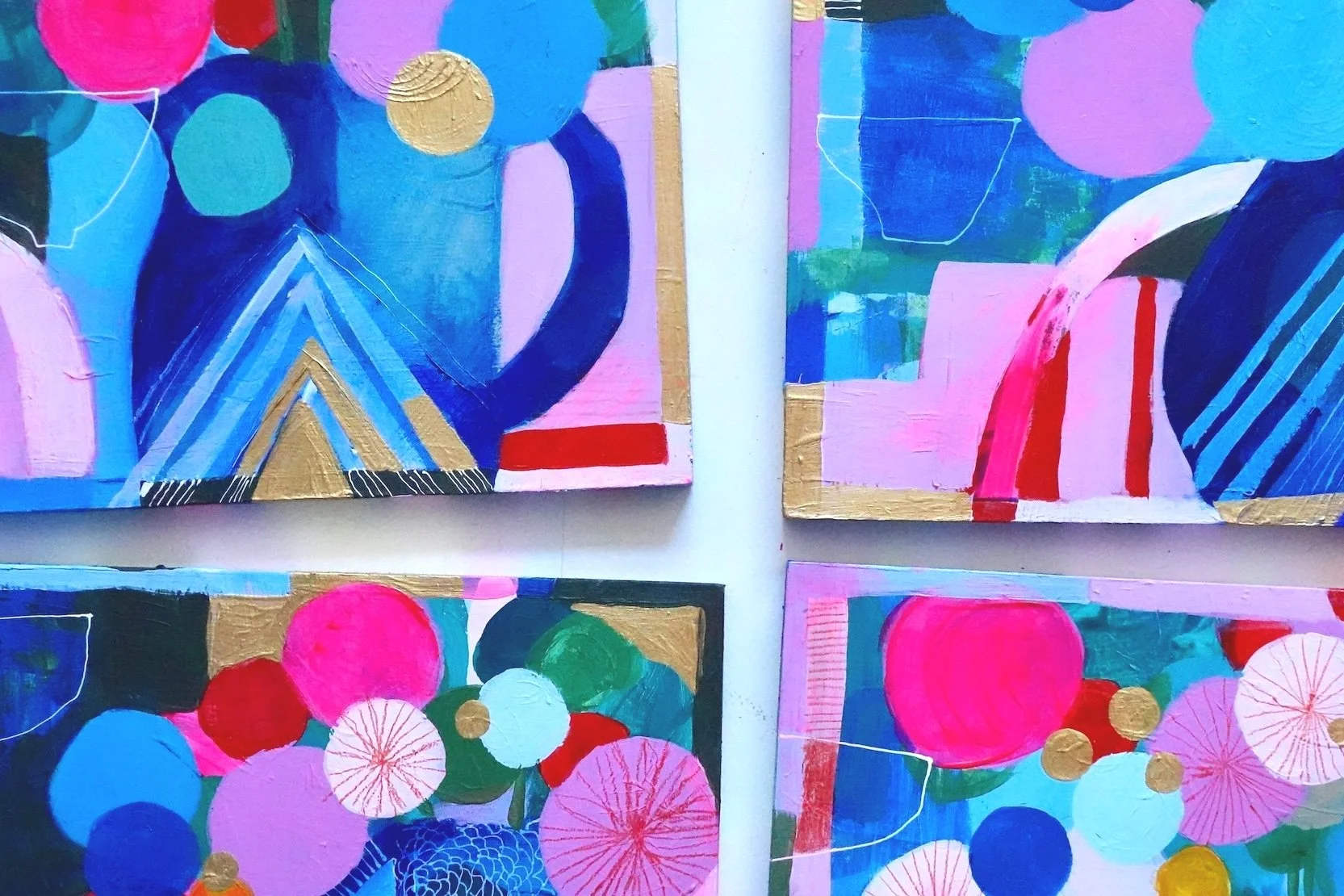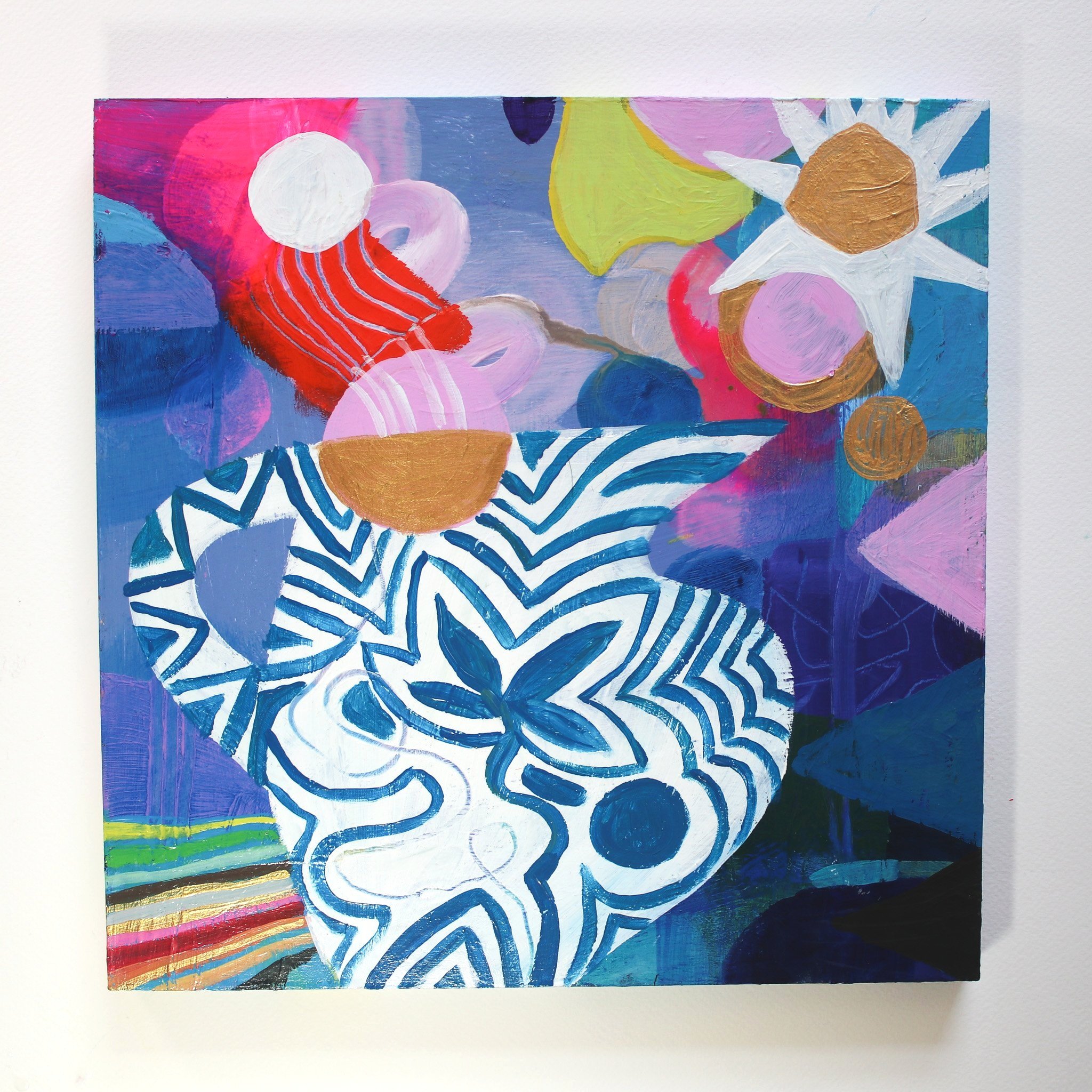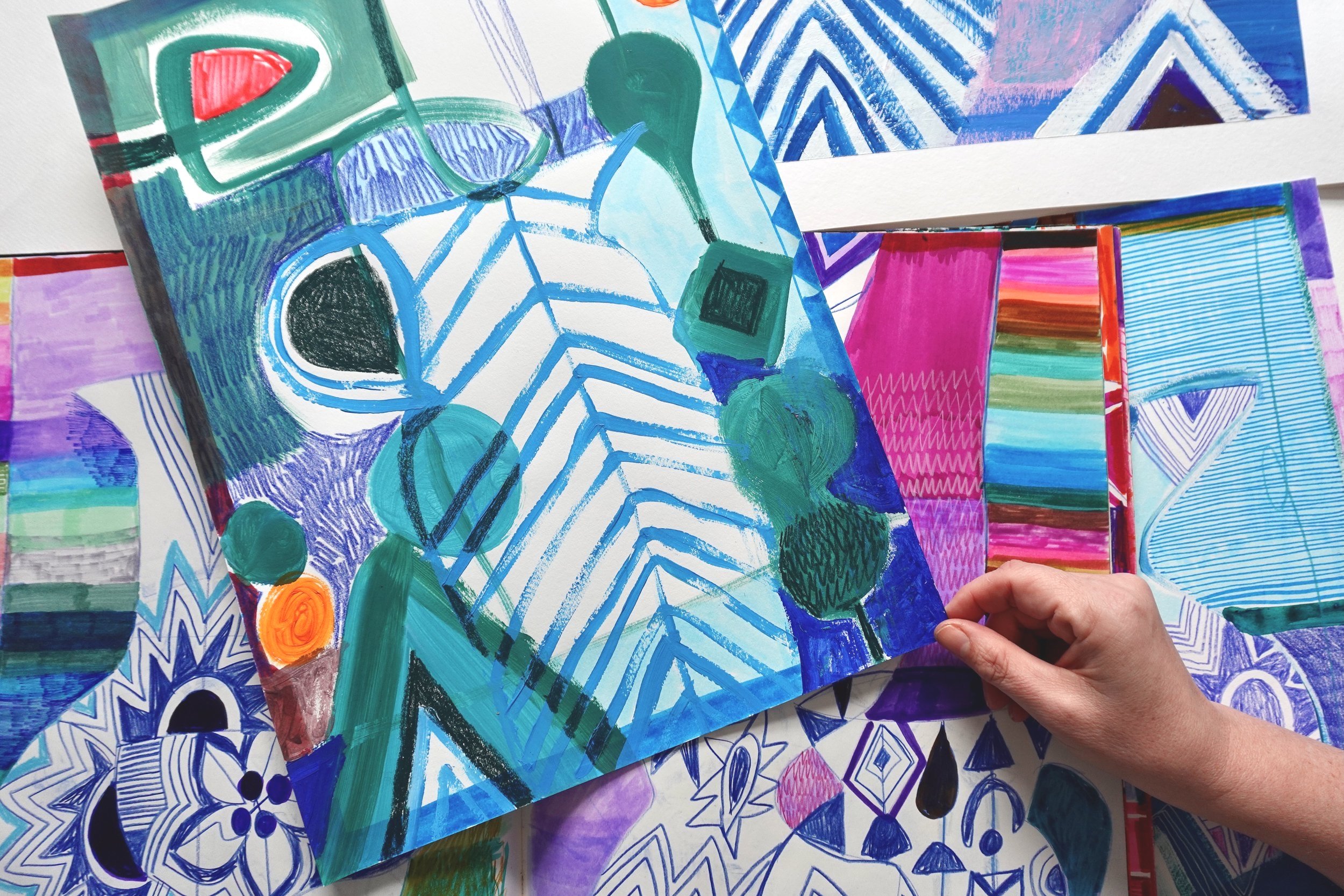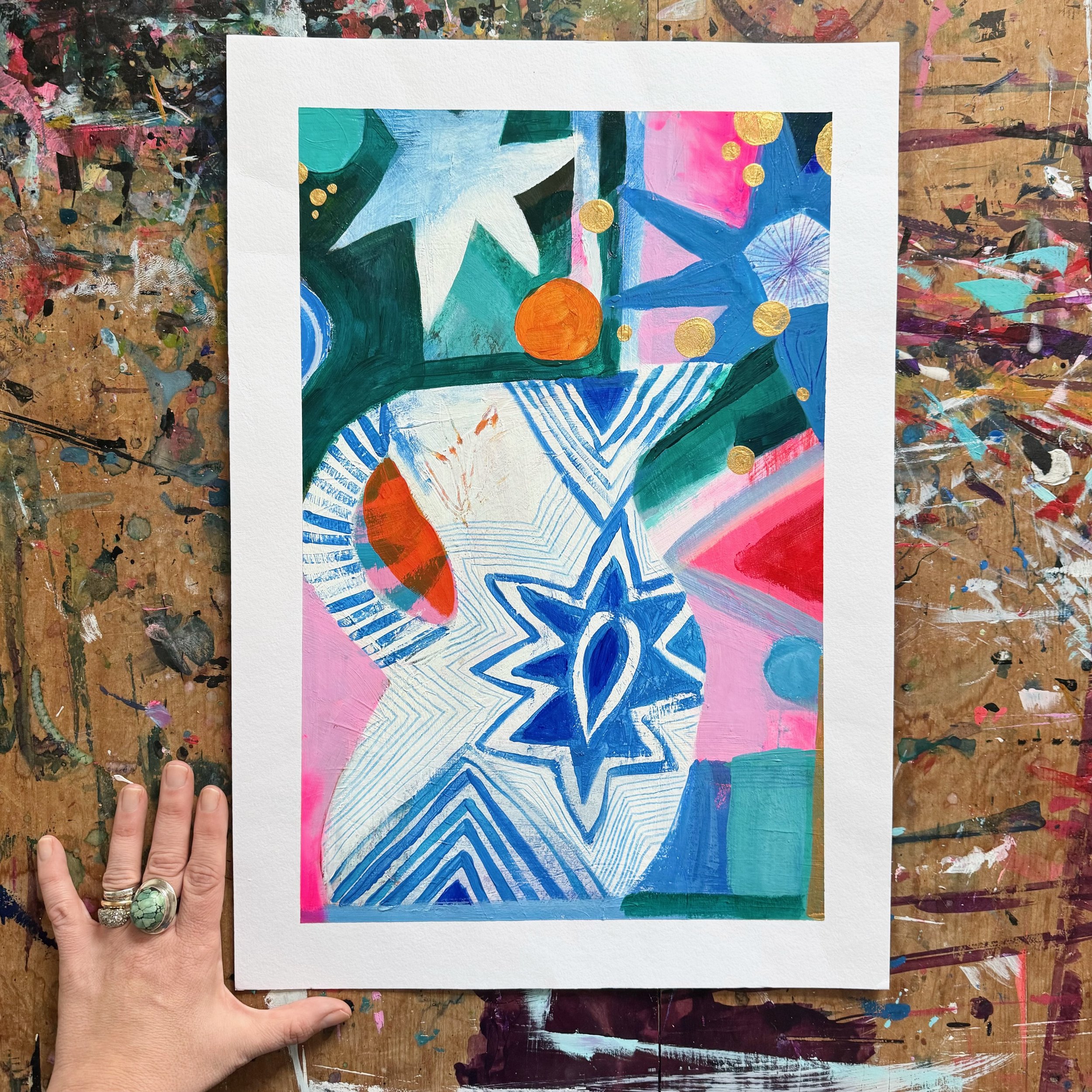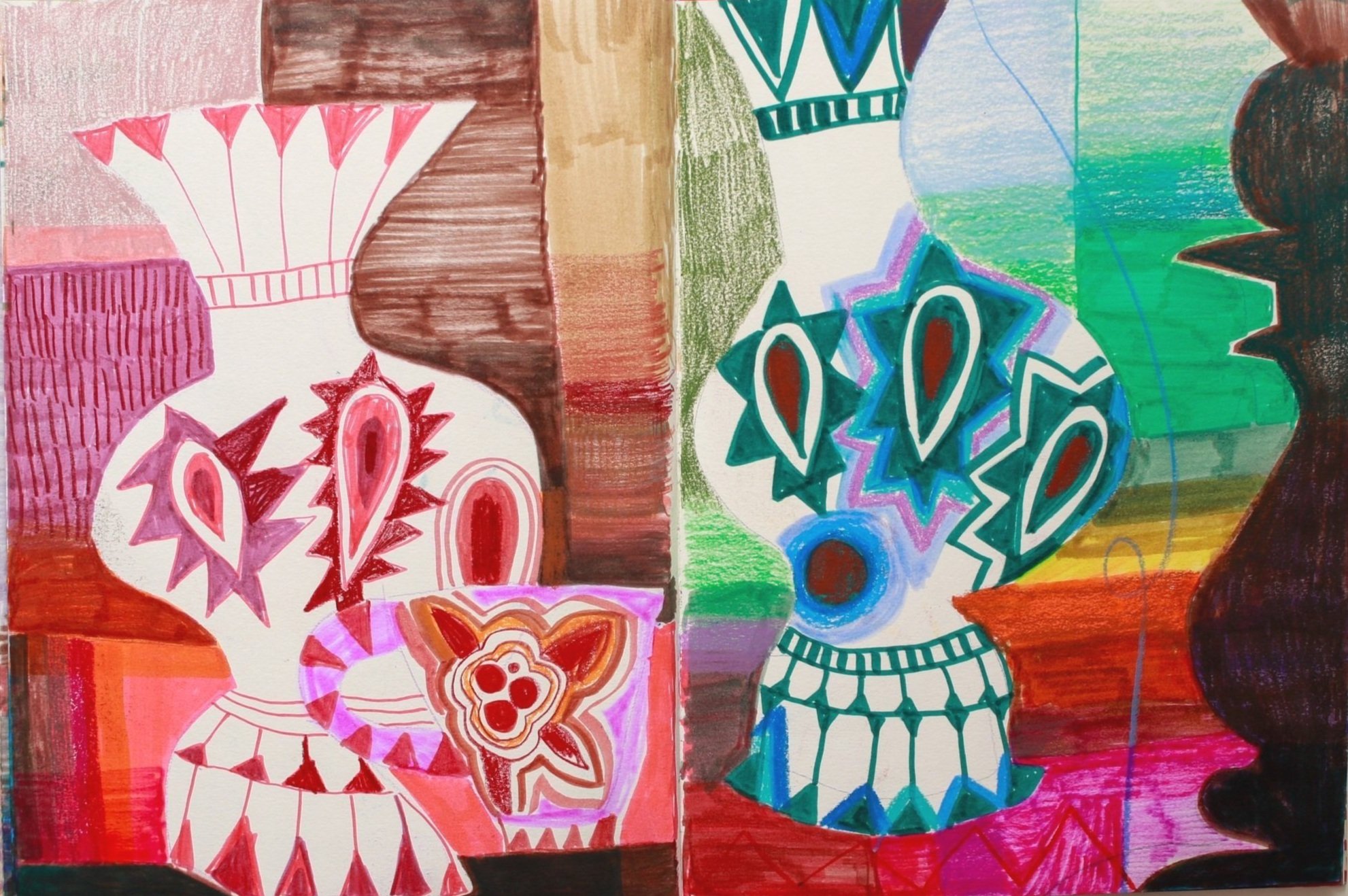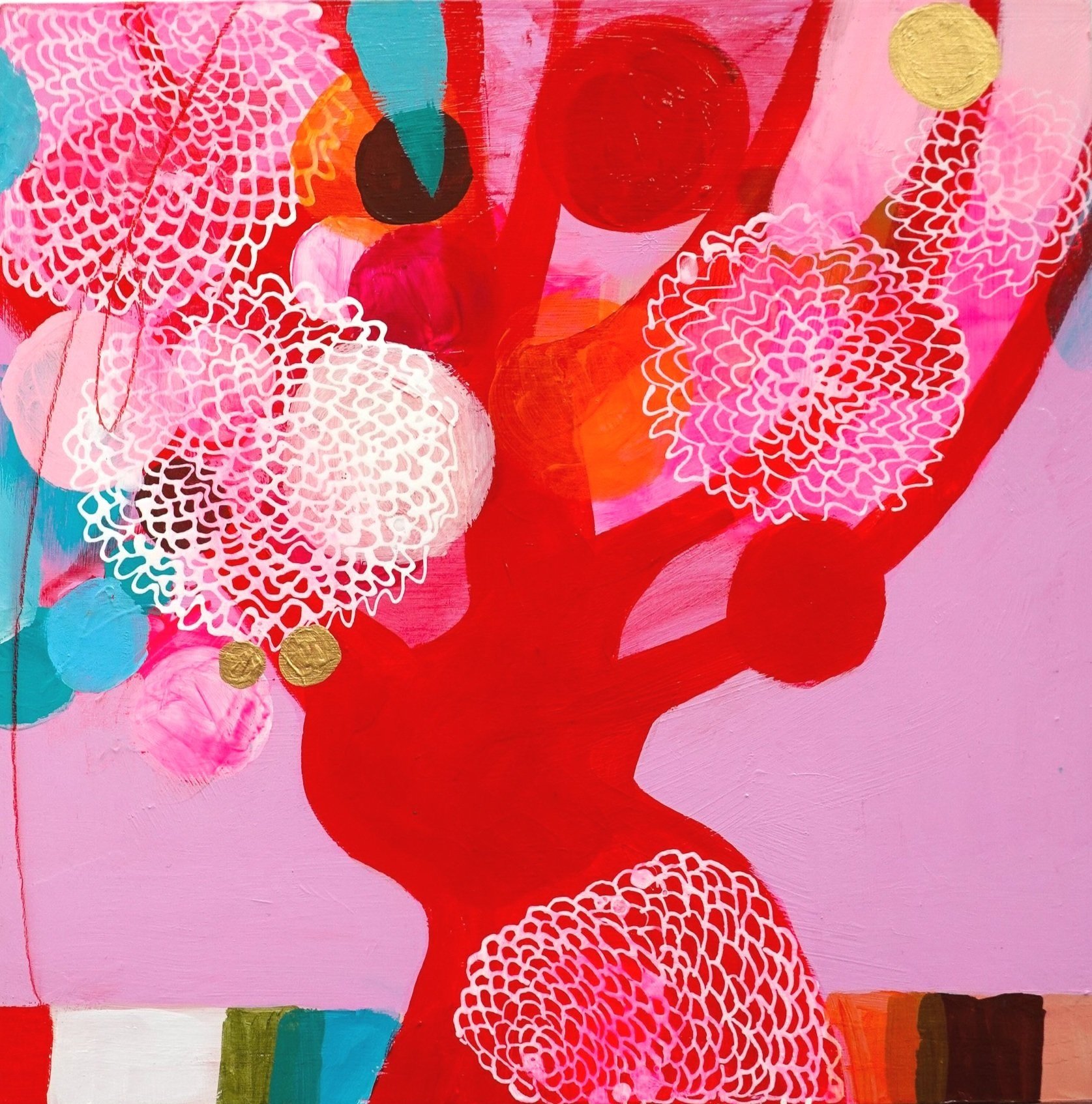
Art making ideasi
Ideas. Inspiration. A little creative mischief.
If you’re drawn to abstract and semi-abstract art, sketchbooks, colour and a little creative mischief, this is your corner of the internet.
In my blog you’ll find stories, videos, inspiration, and gentle nudges to help you create art that feels like you.
This mindset shift which has helped the most…
Some thoughts on mindset and expectations…
Music credit: Ludlow, Masterpiece of Mess
In this video I talk about how my art making changed dramatically when I stopped concentrating on the flaws in everything I created and started appreciating and seeking the things I loved about my own art. This change allowed me to appreciate my personal sensibilities, tune into what made my art feel like mine and improve my skills.
I love this quote from Ira Glass, the American writer and broadcaster. It is about writing but is true and applicable to all forms of creativity…
“All of us who do creative work, we get into it because we have good taste. But there is this gap. For the first couple of years you make stuff, it’s just not that good. It’s trying to be good, it has potential, but it’s not. But your taste, the thing that got you into the game, is still killer.
And your taste is why your work disappoints you. A lot of people never get past this phase, they quit. Most people I know who do interesting, creative work went through years of this. We know our work doesn’t have this special thing that we want it to have.
We all go through this. And if you are just starting out or you are still in this phase, you gotta know it’s normal and the most important thing you can do is do a lot of work.
Put yourself on a deadline so that every week you will finish one story. It is only by going through a volume of work that you will close that gap, and your work will be as good as your ambitions. And I took longer to figure out how to do this than anyone I’ve ever met. It’s gonna take awhile. It’s normal to take awhile. You’ve just gotta fight your way through.”
IRA GLASS QUOTED IN 2009 WHEN TALKING ABOUT THE THE ART OF STORYTELLING ON CURRENT TV
This idea is true not just for beginners but for everyone who is at a point of transition, or trying something new or integrating a new process into their existing approach.
Our ambitions can be greater than our abilities and that is just part of the creative process…my advice is to keep going and keep paying close attention to what you like, enjoy and care about in your own work…
Collages made from magazines
A simple art exercise and thoughts on less than perfect outcomes…
Music credit: Don’t Give up on Love by Ludlow via Epidemic Sound
In this video I share a small creative exercise: making collages from our imagination and an old magazine.
SIMPLE BUT NOT EASY
This kind of simple art exercise or challenge is an important part of my art journey. The premise is simple but the execution is not always easy. It involves thought and problem solving and working within constraints and trying to make something from not very much…
REFINING SKILLS
Just like any other discipline, art requires practice to refine skills, to develop self awareness and expand our zones of comfort. I enjoy incorporating small challenges into my art making, whatever the outcome may be. Being relaxed about the outcome is key, I think.
HAPPY WITH AN AVERAGE OUTCOME
I’ve now learned to be happy with not always loving what I create, particularly if iI’m just exploring or doing exercises.
I know that making average stuff is just part of art making. It’s actually a really important part…. It has taken me a long time to understand this though.
I used to think that everything I created must look lovely. That if I created something ugly it meant I wasn’t a good enough artist. I was insecure in my own abilities and wanted my work to somehow prove to myself that I was indeed good enough. This desire for perfection did not help me make better art, it added a weight of expectation and too much pressure. It just caused me unneccessary suffering along the way and a feeling of stuck-ness.
Putting too much significance on the outcome and wanting something to look good meant I became stuck doing the things I knew I could do. It meant that the joy of art making was always wedded to the outcome. It also meant that I didn’t allow myself to take any risks or push myself. Now I fully accept that not everything I create will work out how I want it to and actually if it always does I’m probably playing it too safe. Ofcourse I still want to make beautiful art that feels good to me, but I believe that creating art that I really love comes from creating lots of art, sometimes successful and sometimes not so much….
Art materials: felt tip pens
Some of my favourite felt-tip pens
In this video I share some thoughts about using markers and felt tip pens in my sketchbook and share some of my favourites.
I really enjoy using this type of pen in my sketchbook practice, they are quick, portable and accessible. There is something playful, easeful and joyful about them. The brilliantly bright colours seem cheerful, optimistic and exuberant to me.
ART MATERIALS
Here are some of the felt tip pens I like to use, these are just my personal preferences, I tend to mix and match brands to find the colours I like. You may like to explore adding multiple layers of colour on top of each other to build up intensity and get a more unusual colour palette or experiment with combining felt tips pens, with other art materials such as collage and paint…
I mostly use water-based or indian ink based pens in my sketchbook, I find that alcohol based markers always seem to seep through to the page beneath no-matter the paper quality and I find their smell a little overpowering, so I mostly used water based….
These are the brands I use most often:
Pentel Pocket Brush Pen ( this is the black brush pen I use the most which is refillable)
Ecoline Brush Pens ( these pens can be refilled with Ecoline liquid watercolour which comes in bottles)
Faber Castell PITT Artist Pens (indian ink based so waterproof)
Stabilo Pen 68 BRUSH
Staedtler 3001 double ended watercolour brush pen
TomBow ABT Dual Brush Pens
The Faber Castell and Tombow’s are the more expensive high-end ones, they are not cheap, but as a professional artist I do invest in materials. The Staedtler ones I find to be really good quality and excellent value. The Ecoline pens can be refilled. Please don’t feel you need to start with expensive pens, the best felt tip pens to use are always the ones you already own…(or perhaps the ones your kids or grandchildren own!)
Mixing art supplies
Mixing art supplies in a sketchbook
Today I’m chatting about mixing media and combining art supplies…
CONNECTION WITH THE MATERIALS
There is something about the physicality of creating art which I love, the connection to the art materials is part of the joy. I try and choose my art materials with intention, they influence and inform what I make. I relish the sensory and tactile nature of mixing the paint, touching the materials, how the paper feels, the physical connection to what is on the page. I enjoy leaving my mark on the page, the evidence of the physical act of art making is an integral part of my art…
UNEXPECTED DELIGHTS
There is real delight to be found in mixing different types of media and art supplies on one page, the visual variety, the different sensibilities of different art materials combing to create something surprising, interesting or unexpected.
INSPIRED BY THE PROCESS
When making art in a sketchbook, the outcome is not so important, this allows a certain amount of freedom to explore different processes, materials and combinations of materials. The magical element is often what is discovered about the way materials can be manipulated, how they play together...
Abstract art and art books…
A few fascinations and interests…
In this video I share a little of what I am up to in my art practice at the moment, painting on paper, the art books I’m currently reading and loving and a few recent adventures within my sketchbook…
ART BOOKS: John Walker, The Blue Series, Messums Art Gallery, Catalogue, published in 2023
David Mankin, Remembering in Paint by Kate Reeve Edwards, published by Samson & Company 2021
MUSIC CREDIT: If I wrote you a song, by Melanie Bell vie Epidemic Sound
Abstract art: progression and process
The stages of an abstract painting and a few thoughts on process…
Today I wanted to share a little insight about how my paintings progress and develop. I thought I’d show you some abstract paintings I’m currently working on at different stages of un-dress and un-doneness.
ALIGN THE PROCESS WITH THE INTENTION
Every artist has a different process and it’s important that the process you choose to use or develop reflects the things you are interested in. Our processes are a vital part of the mix, they are part of our art decision making, part of how we want our art to feel and be.
There is no one way to paint a painting. I try and ensure that the way I paint a painting emphasises and aligns with my sensibilities and reflects how I want my art to feel…
So for example I love delightful details, layers of complexity, rich maximalist combinations, I want my art to be bright and playful but also have a depth and complexity. I enjoy exuberance AND control. I like a sense of seeking and finding. I enjoy my paintings when they feel like they have a history, like they are interesting objects with a past. I want to celebrate beauty in the mundane. And because I have really thought about all this, I am better able to develop art making processes which give me these results.
TWO QUESTIONS
So in a nutshell it is useful to think “what are my paintings about?” and “how can my processes support and align with this?”
Art inspired by objects
Art inspired by the objects and things in our lives
In this post and video I want to talk about how the objects in my life inspire my art.
CONNECTING TO THINGS
I’ve always been super inspired by nature and being outside, trees, organic forms, foliage and flowers. In the last few years though, I have also been fascinated with objects and items in a domestic setting. Art making helps me to connect to myself and the world around me. It is a way to understand who I am and what I am interested in. It is an ongoing conversation with myself which unfurls, develops and evolves.
INSPIRATION IS ALL AROUND
And in recent years a lot of my art has been an exploration of my connection to home and the items that accompany my everyday. The objects and things that I travel through life with.
Why am I so inspired by the domestic?
I’ve been thinking about my relationship to home and the things in it a lot recently.
EMOTIONAL CONNECTION
Over the last couple of years we’ve all spent far more time inside our homes, haven’t we?
When our house flooded and we had to live in hotels for several months, I missed the familiar objects of my day-to-day. The importance of home has perhaps also taken on a different meaning for me since both my parents died. My home now represents a feeling of security and grounded-ness, of roots becoming established.
My home brings together objects and items that I love, which mean something to me, but also just random things I like and enjoy. I like the fact my home contains a layering of things, some with meaning attached, some picked up in a junk shop just because they are interesting or unique.
I came across this quote from Matisse:
“I have worked all my life before the same objects… The object is an actor. A good actor can have a part in ten different plays; an object can play a role in ten different pictures.” Henri Matisse, 1951
The objects we surround ourselves with play a part in our lives, they are actors on our stage. They may reflect who we are, what we love, our taste, our preferences and our experiences. Our things can be a wonderful source of inspiration for our art making because in some way they are a reflection of us…
If you’re looking for an art process to help you create beautiful abstract and semi abstract acrylic paintings from objects in your life, you may like to check out my class Objects to Abstracts:
My story
My journey to becoming an artist…
I became an artist a little later in life, in my late thirties. I didn’t go to art collage and gave up studying art when I was just seventeen. My route to becoming a full time artist has been a rather circuitous one. I didn’t create anything at all in my twenties, then spent my thirties obsessed with art, but only ever as a hobby. It wasn’t until my forties that art slowly evolved to become my full time career.
As a child, I was always drawing. I dreamed of being a textile designer. I loved spending hours creating elaborate and intricate patterns from my imagination. I used to get through so much paper that my father started to buy me large rolls of wallpaper lining-paper to keep up with my insatiable demand for something to draw on.
Recent artwork
Recent art work
Drawing from 40 years ago
My Mum was studying contemporary textiles when I was little, so she was always sewing or taking me to the haberdashery. Thread, fabric, colour, pattern were the back-drop to my childhood. I have always been fascinated by pattern and colour
But then at seventeen when a school time-tabling clash wouldn’t allow me to study art with my other subjects, I gave up studying art and I gave up creating art and I allowed it to just slip out of my life.
A little bit of heartbreak brought me back to art making. A relationship breakup when I was 28 or 29 left me moping around with no summer holiday plans. I decided to book myself onto a two week painting summer school at a London art college. It was there that I started a much more fulfilling love affair… I fell completely and utterly in love with drawing and painting.
For nearly all of my thirties art was a hobby, I tried to go to art collage and was rejected after a terrible interview, so I just thought that creating art would remain a life enhancing, life enriching hobby.
In my late thirties as I climbed the career ladder at the charity I had worked at for for nearly a decade, I began to feel that perhaps I had laid my ladder against the wrong wall.
I had a clear epiphany out of the blue one day, that I really did want to make art a more significant part of my life… so I set about trying to make art my career.
I took tiny steps in the right direction. I started to try and sell my art online. I entered competitions and group shows and slowly and surely things started to happen. I won a Winsor & Newton watercolour competition which meant my art was displayed at The Saatchi Gallery in London. Eight of my paintings were displayed at one of Gordon Ramsay’s restaurants… I build my confidence, learnt new skills and made art my part time career and then eventually my full time career.
Recent sketchbook pages
Recent sketchbook pages
I’ve now patch-worked an art career together through trial and error, finding out what works and what I enjoy. I love the career I have built. I license my work for wall art, branding and products. I sell my original paintings and complete commissions for original art projects such as for hospitals. I have written a book about mixed media sketchbooks and I teach online classes.
Art inspirations and fascinations
Following threads and curiosities…
Creating art is a process of unpacking the things in life which fascinate; a wonderful way to explore obsessions and better understand curiosities. Creativity is a process of discovery and exploration.
By making art, I have discovered more about my self and the world I inhabit.
It has encouraged me to meet myself on the page, to become clearer on what moves me, motivates me, interests me and lights me up. To follow the threads of my curiosity and weave them together.
EXTERNAL WORLD
The process of creating art has ignited multiple and diverse love affairs for ancient textiles, seaweed, fossils, found patterns, painted ceramics, trees roots, sacred geometry, weeds, patterned rugs, reflections on water, hand embroidery, folk art, iridescence....
It has connected me to tthe world around me in a tangible life-enriching way. I notice more of what I am curious and fascinated by.
INTERNAL WORLD
It has also prompted me to tune-in to my own sensibilities. Why do I create art in the way that I do? What is my art about? I would say my art is about delightful details, beauty in the mundane, seeking and finding, layers of complexity, reveling in colour, fragments of wonder and awe, exuberance and control, moments of joy, combinations and juxtapositions, threads through time…
I want my art to feel expressive, joyful, combine exuberance with quietness, be bright, playful, interesting, complex.This is also how I want my life to feel, what excites me in my art is what I seek in my life and what I seek in my art is what excites me in life..
Drawing and exploring
Thinking through doing…
In this video I share a little of my art process when creating something new. I like to draw and explore with different materials and approaches, think through doing… gradually unpack an idea. Get stuck in and see where it takes me.
Abstract art and art books
Abstract art and art books
MUSIC CREDIT: If i wrote you a song, by Melanie Bell via Epidemic Sound
In this video I share a little of what I am up to in my art practice at the moment, painting on paper, the art books I’m currently reading and loving and a few recent adventures within my sketchbook…
ART BOOKS:
John Walker, The Blue Series, Messums Art Gallery, Catalogue, published in 2023
David Mankin, Remembering in Paint by Kate Reeve Edwards, published by Samson & Company 2021
My favorite types of sketchbook
Some of my favorite types of sketchbook and thoughts on filling them up
WHY I LOVE SKETCHBOOKS
Sketchbooks are a place where I make art for myself. The pages are not necessarily filled with ‘sketches,’ the art is not necessarily a draft for something more important, although it can be, I think of my sketchbooks as a place where I experiment and express myself. Sketchbooks are where I gather together the hints, whispers and clues of my artistic practice. Sketchbooks are the filing cabinets for my art making. They are a place to collect and curate small delights and large curiosities. They are a place to make for the joy of creating, a place to find a path through, problem solve, follow a thread. They are both a homecoming and an adventure…
FILLING UP A SKETCHBOOK
I used to abandon sketchbooks after a few pages. Now I try to always fill them up, I’ve found that the more art is in a book the more inspiring I find it to work in, it gains a momentum, I often prefer what I’ve made in the second half of the book. There is something about a full sketchbook that gives me pride, the fact I am able to keep going and fill one up, it feels like an achievement.
I still find the first few pages of a sketchbook to be a little daunting though, sometimes I don’t even start on the first page, but rather I start a few pages in and circle back to fill in those first few pages when the sketchbook has found its footing…and I’m feeling more assured.
MY FAVOURITE TYPES OF SKETCHBOOK
Here are the types of sketchbook I use the most, these are just my personal preferences, the ones I like to use or buy.
1. VENEZIA BOOK FROM FABRIANO
I use different sketchbooks for different things and tend to have more than one on the go at once. For my main studio sketchbook I use a Venezia Book from Fabriano, it is my favourite. I like the paper which is 200gsm or 90lbs in weight, I use the version that is 23cm x 30 cm `which lays flat. It’s a good size for me and can take quite a lot of collage material and wet paint.
2. STILLMAN & BIRN ZETA RANGE
I buy the square version of this sketchbook which has beautiful smooth 270gsm paper and is 19cm x 19cm.
3. POCKET SIZE CONCERTINA SKETCHBOOK FROM SEAWHITE OF BRIGHTON
This is an accordion or concertina sketchbook made from long folded pieces of paper. These are small, portable and quick to fill as they are only 17.5cm x 9cm. The paper isn’t that thick but because the book is constructed from two long sheets of paper joined together it feels thicker than its 140gsm paper weight. It comes with a hard carrying case and I find it great for working outside or carrying about in my bag. It has two long pieces of paper, folded into pages and I enjoy working across these expanded surfaces and folding the pages in and out to see what I have created with new eyes.
4.DALER ROWNEY A3 ARTIST’S HARD BACK SKETCHBOOK
These hard backed sketchbooks are really large, it’s an A3 size which means a double page spread is A2. The paper is smooth acid free 160gsm and it contains 48 sheets or 48 double page spreads.
5. HANDMADE AND HOMEMADE ART BOOKS
As part of my overall sketchbook practice I love making all sorts of quick handmade, small art books and sketchbooks. I often make them from offcuts and oddments and abandoned and unloved pages and scrap paper and they become something new and interesting. To me a small homespun sketchbook feels quite liberating and joyful to create in. The stakes are low and so I perhaps create with less weight of expectation and more experimentation…
Artist research: questions and answers
Artist Research Page. Some questions and answers about my process and inspirations
I am lucky and honoured to get lots of questions from students so here is an artist research page to help answer some questions.
Describe your work:
My artwork is sometimes intuitive and intricate and sometimes bold and colourful. It often features motifs from nature or the world around me. I use expressive mark making to create abstract pieces which feature repetition and rhythm, layers of complexity and organic forms. I’m fascinated by the interplay of colours, shapes and patterns. My paintings are rarely envisioned but develop over days as I respond to the materials and the marks on the page, creating complex layer pieces full of colour and detail.
What are you inspired by?
I’m mesmerized by the beauty, colour and pattern in the natural world and in the world around me. I’ll frequently have a love affair with something where I become obsessed with it for a while; from snow flake structures, to patterns on shells, or the colours and patterns on fish scales, or antique Indian textiles, or bird feathers or butterfly wings, or the patterns on maps… I also have some magpie tendencies and am rather drawn to the glittering and glinting, iridescent or luminous… I try and seek inspiration everywhere - I will go out and walk in nature or around my home with my camera - seeking small details and interesting patterns and shapes.
What processes do you use to create your art?
I experiment in my sketchbooks and will sometimes take a seed of an idea from these and use it as a springboard for a larger work or series of work. My sketchbooks are the foundation of my artistic practice, they are where I try things out, experiment and reflect on my curiosities and fascinations.
My sketchbooks allow me to gather themes and fragments of ideas that I may want to explore more, I can look back on my sketchbooks and see whispers of ideas forming and recurring motifs and fascinations emerging. I rarely copy something from my sketchbook into a larger piece, but my sketchbook is where ideas, motifs, art material mixes ‘develop’ and then these recurring themes turn up in my paintings. I don’t ever really plan out a painting, I have a tiny starting part, a colour or a shape or a detail and I begin and respond to what emerges.
How did you develop your art style?
We all have a unique way of seeing and interpreting the world and our art is a reflection on this. My style developed from making lots of art, reflecting on the art I had made and getting curious about the aspects of it that excited me… and doing more of that. I believe my art style is always evolving and developing, it isn’t a landing spot, it’s a conversation that continues and evolves.
When did you know you wanted to be an artist?
As a child, I was always drawing. I loved spending hours creating elaborate and intricate patterns from my imagination. I used to get through so much paper that my dad started to buy me large rolls of wallpaper lining-paper to keep up with my insatiable demand for more paper. I used to have a large box in which I collected shiny and patterned papers, from sweet wrappers, pages torn from magazines, bits of shiny wrapping paper. I loved my “special paper” box, I used to like tipping it on the floor and seeing how the different patterns and colours combined with each other. So, drawing and painting was something which came innately to me as a child. But I only became a full-time artist later in life. I took a rather circuitous route to get here as a profession and it is perhaps all the sweeter for it.
Why do you make art?
* It’s fulfilling to make something from nothing
* When I’m in flow it can be meditative and absorbing to work with my hands
* I enjoy the problem solving, overcoming the obstacles, the satisfaction from keeping going when something isn’t working and finding a way to resolve it in some way
* It helps me to see the world with new and curious eyes, it brings more wonder and awe into my life
* I relish the sensory pleasure, the materials, the tactile nature of art supplies and paper
* It brings joy, colour and pattern into my life
* It helps me to respond to and interpret my interior world and the world around me
* I notice more, pay more attention to details and become more fascinated by random and unexpected beauty
* I uncover, discover and explore my interests and come up with new ones
* I enjoy the learning and the development, trying new things, exploring new techniques, the sense of possibility
* It is a way to find myself, express myself and be myself
* It feels nourishing and good for my soul and wellbeing
* Art making helps me to connect to myself and the world around me
* It is a way to understand who I am and what I am interested in. My art is my response to being in the world. It is an ongoing conversation with myself which unfurls and develops…
Where do you work?
I am very lucky to have two rooms at the top of our house in Hastings. I’ve painted the walls and floor white to maximize the light. Having painted wooden floors also means I can roll back the rugs and make a real mess without any worries. I love rugs and have them everywhere, bright bursts of colour and pattern that sing to me. So, although the walls and floor of my space are white, the space is far from minimalist.
I love collecting weird and wonderful objects and picking up old or unusual objects in junk shops. My place is scattered with old tins, patterned ceramics, pebbles from the beach, old books and interesting textiles.
The house is half way up a hill, so one of the rooms has an amazing view of the town and sky. I just love this view and find the ever changing colours and patterns of the clouds a great inspiration. Having two rooms, means I can move around depending on the time of day – leave artworks to dry, whilst packing others.
Where do you seek inspiration?
Sometimes being an artist is like being a visual adventurer. I am always on the lookout for colours, patterns, tiny inspirations that I can collect, expand upon and use in my paintings. Sometimes these come through active searching, I might take a walk on the beach or in nature to actively seek-out some inspiration, looking at the details of plants and the shapes of the leaves, patterns on pebbles, or the way the water creates lines in the sand.
What art materials do you use?
I love to mix art supplies and mix mediums. I like to experiment, explore and combine different art materials to create layers of interest and variety. I am always trying out new mixes and combinations to see what resonates with me. I love watercolour with fine-liner pen. Acrylic paint with photocopies. White ink pen over black ink. I enjoy using unexpected art making tools such as twigs or pieces of discarded ephemera.
When and where were you born?
I was born in London in 1975.
The power of creativity
Some thought on creativity….
I believe that the more creativity we can incorporate into our day-to-day lives the more fulfilling, interesting and meaningful our lives become. Here, I share a few of my thoughts on everyday creativity.
What is creativity
Creativity is making things. Creativity is breaking out of a rut. Creativity is doing things differently. Seeing things from a different perspective. It’s inventiveness, playfulness and experimentation. My idea of what constitutes creativity and your idea will be completely different and that is part of the magic. Creativity is personal and is an expression of self.
Why is creativity important
For many years I didn’t do anything creative at all – and that makes me sad. I now know that being creative brings pleasure, fulfilment and meaning. Creativity carries with it a sense of possibility and optimism. Creativity is a form of self-expression; it allows us to have a conversation with ourselves about our fascinations and curiosities. Creating things allows our head, heart and hands to work in unison.
Untapped creativity
Being creative can bring joy, delight and light. But if you’re not using your innate creativity it’s not just a missed opportunity, it has consequences. Brene Brown writes powerfully about what happens to our untapped creativity:
Unused creativity is not benign. It metastasizes. It turns in to grief, rage, judgment, sorrow, and shame.
— BRENE BROWN
I like to challenge myself to be creative in small ways.
Doing things differently
I like to think about how I can do things differently, or in a new way to disrupt the hum-drum a little. So, whether its walking a different way, putting an outfit together differently, cooking a new recipe, seeking an unusual ingredient, going to places I’ve never been to before, reading up about a subject which I know very little about, I’m an artist so I might read about an artist I don’t know much about, I might try using an art material or a way of making I’ve not tried before……I invite you to disrupt your habitual patterns just a little by challenging yourself to try new things or do things in different ways..
Looking and finding
I go out looking for inspiration, actively seeking new or interesting sights and places, finding and consciously absorbing details more closely than before. I like to take note and photograph things which surprise and delight me, things which I find beautiful or intriguing. Sometimes I just go for a walk wth my camera phone to find visually pleasing details, new angles and perspectives around my neighbourhood. Try it for yourself so what you can find when you pay close attention.
A stolen window of time
I love the idea from Julia Cameron of an artist’s date. This is where you set a creativity date with yourself and you do something nourishing, a stolen window of time to spend on your own, doing something ‘enchanting’, creative and fun for yourself and by yourself.
Making a list
Documenting ideas, capturing and curating them can be powerful. I like to write down all of the ways in which I could challenge myself, do things differently, things I’d like to try, things I enjoy, a running list to remind me and nudge me. I might include materials I want to explore further, artists I want to read more about…. I find that writing these things down helps to keep them alive and prevents them from getting lost to the ether… this list can be a useful route map for those days when inspiration is lacking…
So that’s just a few thoughts on creativity. I wish you lots of luck in all your creative pursuits and endeavours. Creating things for the sake of creating things can be a magical thing to do…

